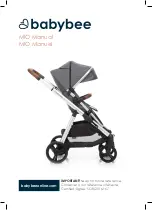
5-266
M60 MOTOR PROTECTION SYSTEM – INSTRUCTION MANUAL
GROUPED ELEMENTS
CHAPTER 5: SETTINGS
5
Settings
BF1 MODE
— This setting is used to select the breaker failure operating mode: single or three pole.
BF1 USE AMP SUPV
— If set to "Yes," the element is initiated if current flowing through the breaker is above the supervision
pickup level.
BF1 USE SEAL-IN
— If set to "Yes," the element is sealed-in if current flowing through the breaker is above the supervision
pickup level.
BF1 3-POLE INITIATE
— This setting selects the FlexLogic operand that initiates three-pole tripping of the breaker.
BF1 RETRIP PICKUP DELAY
— This setting specifies a pickup delay for the re-trip command. Set this delay longer than the
possible spurious contact input activation duration due to transients or temporary DC grounds, taking into account the
contact input de-bounce time to avoid re-trip operation for such transients.
BF1 PH AMP SUPV PICKUP
— This setting is used to set the phase current initiation and seal-in supervision level. Generally this
setting detects the lowest expected fault current on the protected breaker. It can be set as low as necessary (lower than
breaker resistor current or lower than load current)—high-set and low-set current supervision guarantee correct operation.
BF1 N AMP SUPV PICKUP
— This setting is used to set the neutral current initiate and seal-in supervision level. Generally this
setting detects the lowest expected fault current on the protected breaker. Neutral current supervision is used only in the
three phase scheme to provide increased sensitivity. This setting is valid only for three-pole tripping schemes.
BF1 USE TIMER 1
— If set to "Yes," the early path is operational.
BF1 TIMER 1 PICKUP DELAY
— Timer 1 is set to the shortest time required for breaker auxiliary contact Status-1 to open, from
the time the initial trip signal is applied to the breaker trip circuit, plus a safety margin.
BF1 USE TIMER 2
— If set to "Yes," the main path is operational.
BF1 TIMER 2 PICKUP DELAY
— Timer 2 is set to the expected opening time of the breaker, plus a safety margin. This safety
margin was historically intended to allow for measuring and timing errors in the breaker failure scheme equipment. In
microprocessor relays this time is not significant. In M60 relays, which use a Fourier transform, the calculated current
magnitude ramps-down to zero one power frequency cycle after the current is interrupted, and this lag needs to be
included in the overall margin duration, as it occurs after current interruption. The Breaker Failure Main Path Sequence
figure that follows shows a margin of two cycles; this interval is considered the minimum appropriate for most
applications.
Note that in bulk oil circuit breakers, the interrupting time for currents less than 25% of the interrupting rating can be
significantly longer than the normal interrupting time.
BF1 USE TIMER 3
— If set to "Yes," the Slow Path is operational.
BF1 TIMER 3 PICKUP DELAY
— Timer 3 is set to the same interval as timer 2, plus an increased safety margin. Because this
path is intended to operate only for low level faults, the delay can be in the order of 300 to 500 ms.
BF1 BKR POS1
φ
A/3P
— This setting selects the FlexLogic operand that represents the protected breaker early-type auxiliary
switch contact (52/a). When using the single-pole breaker failure scheme, this operand represents the protected breaker
early-type auxiliary switch contact on pole A. This is normally a non-multiplied form-A contact. The contact can even be
adjusted to have the shortest possible operating time.
BF1 BKR POS2
φ
A/3P
— This setting selects the FlexLogic operand that represents the breaker normal-type auxiliary switch
contact (52/a). When using the single-pole breaker failure scheme, this operand represents the protected breaker auxiliary
switch contact on pole A. This can be a multiplied contact.
BF1 BREAKER TEST ON
— This setting is used to select the FlexLogic operand that represents the breaker in-service/out-of-
service switch set to the out-of-service position.
BF1 PH AMP HISET PICKUP
— This setting sets the phase current output supervision level. Generally this setting is to detect
the lowest expected fault current on the protected breaker, before a breaker opening resistor is inserted.
BF1 N AMP HISET PICKUP
— This setting sets the neutral current output supervision level. Generally this setting is to detect
the lowest expected fault current on the protected breaker, before a breaker opening resistor is inserted. Neutral current
supervision is used only in the three pole scheme to provide increased sensitivity. This setting is valid only for three-pole
breaker failure schemes.
Summary of Contents for M60
Page 9: ...TABLE OF CONTENTS M60 MOTOR PROTECTION SYSTEM INSTRUCTION MANUAL ix INDEX ...
Page 10: ...x M60 MOTOR PROTECTION SYSTEM INSTRUCTION MANUAL TABLE OF CONTENTS ...
Page 552: ...5 344 M60 MOTOR PROTECTION SYSTEM INSTRUCTION MANUAL TESTING CHAPTER 5 SETTINGS 5 ...
Page 660: ...iv M60 MOTOR PROTECTION SYSTEM INSTRUCTION MANUAL ABBREVIATIONS ...
















































